There is substantial interest in growing crops in closed controlled environments, yet the energy requirements are high. Energy is required to produce light, but also to remove the heat generated when producing light. The goal of the current work examines a possible approach to decrease the energy requirement. The effect of pulsed light treatments was examined by monitoring seedling traits during early photomorphogenic development. Daily light integral remained unchanged between treatments, but the frequency of the pulses was varied.
Developmental traits (such as inhibition of hypocotyl elongation rate) were most conspicuous during a normal photoperiod, as in twelve hours light, twelve hours darkness. Consistent with historical reports, when treatments were delivered in shorter durations (e.g. 1 hour on/off) photomorphogenic development was hindered, with the same daily light integral. However, at even shorter light intervals (e.g. seconds) seedlings developed as if they were provided full 12 h treatments. Extension of the dark period following a 5 s pulse was tested to determine the effect on seedling traits.
The results showed that the dark period could be extended to at least 10 s without affecting seedling development, and extension to 20 s only had slight effects on seedling traits. The mechanism of the phenomenon was examined in Arabidopsis photosensory mutants, with substantial contributions from the phyA and cry1 pathways.
The results suggest that pulsed light with extended dark periods can decrease energy input by at least 30% to >50% without affecting visible seedling traits. These pilot experiments in seedlings demonstrate that implementation of short-interval, pulsed-light strategies may lower energy requirements for growing crops in artificially illuminated environments.
Read full, original article: Manipulation of Seedling Traits with Pulsed Light in Closed Controlled Environments































